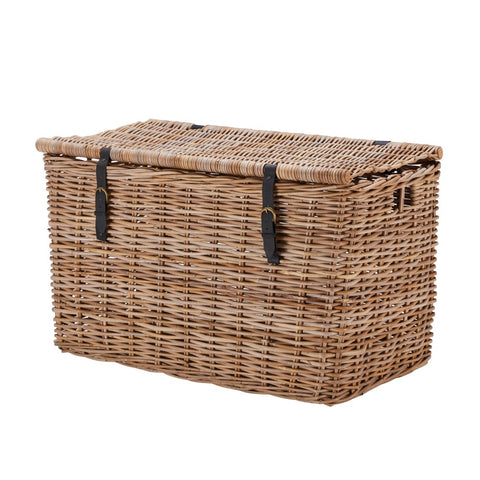Renowned for their impeccable quality, appearance and convenience, wicker baskets are an extremely popular storage solution for stylish homes.
However, like any furniture addition or storage solution, it's not uncommon for these baskets to accumulate dust, dirt, and other types of debris if left without any maintenance for extended periods - which can compromise their appearance and even their structural integrity over time.
In this article, we’ll share the most practical tips and tricks to help you maintain the beauty and durability of your wicker baskets. So, whether you've had your wicker baskets for some time or just starting to incorporate them into your decor, keep reading to learn how to keep them clean and looking their best!
Read on to discover how to clean wicker baskets…

Kubu Rattan Storage Trunk - shop now.
How often should you be cleaning your wicker baskets?
Cleaning a wicker basket for the first time may seem daunting, especially if you're unfamiliar with how to do so. However, with the right techniques and tools, you can effectively clean your wicker baskets without causing any damage to their delicate fibres. And trust us - thoroughly cleaning your wicker baskets is easy!
How often you should be cleaning your addition will ultimately depend on what you use the wicker basket for. See below for a general guideline.
- For food storage - if you use wicker baskets for food storage, such as within a pantry environment, clean your wicker baskets every few weeks to ensure the basket does not contain dust or food particles.
- For toy storage or general storage - to keep your miscellaneous items or children’s toys stored in a hygienic environment, clean the basket once every couple of months, depending on the frequency of the toys being used.
- For decorative purposes - wicker baskets that go untouched and are used purely for decorative purposes will likely only accumulate dust, meaning they can be maintained by the occasional dusting and thoroughly cleaned every six months.
- For bathroom storage - wicker baskets used within a bathroom setting will require a little more close attention due to being in a moisture-rich environment. As mould can thrive under these conditions, clean your bathroom storage baskets once a month.
- For firewood storage - it’s no secret that firewood storage next to a fire feature can get a little messy, especially if you’re an avid user of firewood! Plus, it’s also an environment where mould or mildew can thrive. So, clean a wicker basket used for firewood storage once a month.
What you’ll need to thoroughly clean your wicker baskets
Before you start cleaning your wicker baskets, you’ll want to ensure you have everything you need to do so perfectly.
There are two best ways to thoroughly clean your wicker baskets, and depending on which method you choose, you’ll require different tools to help you achieve the best results.
So, to provide you with the most straightforward ways to ensure your wicker baskets are thoroughly cleaned, we’ve separated our advice on how to clean your wicker baskets into two categories.
Cleaning a wicker basket with a hoover - what you’ll need
- Access to a hoover that has a soft brush attachment (of course!).
- A bowl of lukewarm water.
- A microfibre cloth.
- Mild soap (optional but recommended).
- A clean and dry towel.
Cleaning a wicker basket with soap and water - what you’ll need
- A bowl of lukewarm water.
- A microfibre cloth.
- A toothbrush.
- A small paintbrush or a duster.
- A mild soap or a mild detergent.
- A clean and dry towel.
Cleaning your wicker basket with a hoover - a step-by-step guide
- Start by making sure that the basket is completely empty. Remove the liner (if there is one), and leave the contents of the basket to one side, ready to store away once again once you’ve finished cleaning.
- Shake off any loose dust particles or debris from the basket.
- Take the hose of your hoover and attach the soft brush.
- If it doesn’t come with a soft brush attachment, skip to our step-by-step guide that doesn’t involve using a hoover. Without this attachment, you risk the hose scratching your basket.
- Next, turn on your hoover, and using your soft brush, gently run the brush over the wicker basket. Be sure to get into the little nooks and crevices (as much as possible, anyway!).
- After you feel you’ve done as much as you can using your hoover, turn it off and place it to one side. Then, grab your microfibre cloth and soapy water.
- Soak the microfibre cloth and ring it out thoroughly. Then, simply wipe all areas of your wicker basket.
- Once satisfied, take your clean towel and pad down your wicker basket.
- Lastly, leave your wicker basket to finish drying naturally, out of the way and in a cool space.

Grey Wash Rectangular Log Basket with Wooden Handles - shop now.
Cleaning your basket with soap and water - a step-by-step guide
If your hoover doesn’t have a soft brush attachment, don’t worry - you can still thoroughly clean your basket without it. See below for how.
- Similar to the steps outlined above, start by removing the contents of your basket, placing them on one side, and giving it a thorough shake to remove any loose dust or debris.
- Then, submerge your microfibre cloth in a bowl of lukewarm water. Be sure to ring it out thoroughly before cleaning your wicker basket.
- Next, take your damp microfibre cloth and begin to wipe your wicker basket down. Do this gently, and cover as much of the basket as possible.
- Be mindful of not pushing down too hard on the basket!
- Next, place your microfibre cloth back into the bowl of water, and grab your small (unused) paintbrush.
- Dip your paintbrush in the bowl of water, and use it to gently clean and get into the crevices and hard-to-reach areas of the wicker basket. Don’t try to do this step with your microfibre cloth, as the soft bristles of the paintbrush will help prevent any damage to the wicker.
- Next, place your paintbrush on one side and give your wicker basket a gentle once-over with your microfibre cloth to remove any residue that may have been left behind from the paintbrush. Remember to ring out your microfibre cloth thoroughly beforehand.
- Lastly, softly pad down your wicker basket using a clean and dry towel, and leave it to air dry in a well-ventilated space in your home.
What to do if you spot a mould build-up
If you happen to spot any mould on your basket, there are steps you can take to safely (and swiftly!) remove it from your wicker basket. See how below.
What you’ll need
- A toothbrush.
- A microfibre cloth.
- A bowl of one part white vinegar to four parts of clean water.
- A bowl of lukewarm water.
How to remove mould
- Dip your toothbrush into your solution.
- Apply your white vinegar and water solution to the area of the basket that contains mould using your toothbrush. Gently rub it away until it becomes loose.
- Leave the formula on the area for several minutes.
- Then, dip a corner of your microfibre cloth into a separate bowl of purely lukewarm water.
- Using the damp microfibre cloth, wipe away the accumulated excess residue, and leave the basket to dry in a well-ventilated area.
What to do if you find stains
If it’s simply a smear, the steps outlined above should help you remove any stains on your wicker basket.
However, if it’s a little more stubborn, simply add a few drops of dishwashing liquid, ideally a formula that doesn’t contain any colouring, into a bowl of lukewarm water.
Then, take a microfibre cloth and gently rub the area that has become stained. Lastly, leave to dry naturally; this should be more than enough to remove any unwanted blemishes or non-permanent discolouration from a natural wicker basket.

Seagrass Rattan Laundry Basket - shop now.
What to do if you notice the basket is damaged
If you find any signs of the basket fraying or the wicker becoming loose, this is also easily fixed.
If you’ve noticed small breaks or splits showing on the wicker weave, firstly, grab some wood glue and a toothpick. Simply apply a small amount of glue to the flat end of the toothpick, and spread it over the end of the damaged fibres.
Then, carefully press the material back into place, holding it down for a moment or two. If necessary, you can use a binder clip or something similar to clamp the damaged area into place just until the glue dries.
Frequently asked questions on cleaning a wicker basket
Do the cleaning instructions outlined above apply to all types of wicker baskets?
Yes, you can use the steps above to thoroughly clean any wicker basket, regardless of size or type. So, it doesn’t matter whether it’s a wicker laundry basket, a soot-covered log basket, a storage trunk or even a large wicker hamper; our instructions will guide you through ensuring that your storage solution remains in top condition.
How can I prevent my wicker basket from becoming stained?
Essentially, as long as you regularly clean your wicker basket, it should stay in impeccable condition. It really is that simple!
However, it’s always best to take preventative steps to prevent your wicker basket from becoming stained. For example, we’d recommend not placing your wicker basket to dry in direct sunlight, as this can cause the colour of the wicker to fade. We’d also recommend not placing your wicker baskets next to foods and beverages known to cause stains if they spill accidentally, such as red wine and coffee.
Can I use bleach to clean my wicker basket?
In short - no. Bleach contains chemicals that are too harsh for natural materials.
We know using bleach to clean is tempting, especially if you spot mould growth. However, if you were to do so, it can actually cause more harm than good to your wicker basket! This is because bleach (or any other harsh chemical cleaning solutions) will dry out natural materials, causing the structure of the basket to weaken. This can mean your wicker basket will become less durable and more susceptible to premature breaking.
Plus, if you were to use bleach to clean your wicker baskets, you’ll likely end up with a blotchy, stained and discoloured wicker basket - which, of course, isn’t the ideal outcome.
Can I use a pressure washer to clean my wicker basket?
NO! A pressure washer is too strong for a natural wicker basket, so it can cause severe damage to your basket, such as fraying or even rupturing parts of the basket entirely.
Plus, due to the pressure of the water flow when using this type of cleaning equipment, excess moisture is likely to seep into the hard-to-reach areas of the basket, which will take a long time to dry out - creating the perfect environment for new mould growth.
So, apart from a hoover that has a soft brush attachment, always remember to hand-clean natural wicker baskets.
Can I use my hair dryer to dry my wicker basket?
It is not recommended to use a hair dryer to dry a wicker basket, simply as the heat and force of the air can cause the wicker to become brittle and break. Additionally, in more extreme cases, if the hair dryer is too close to the wicker or placed on a high-heat setting, it may cause the wicker to scorch or even catch fire.
It is always best to allow the wicker basket to air dry naturally in a well-ventilated area, and out of direct sunlight. You can gently dap any excess moisture away with a clean towel, and then leave the basket to dry. This is much more effective for preserving the beautiful quality and longevity found with natural wicker baskets.
How do I know if my wicker basket needs to be replaced?
Natural wicker baskets are incredibly durable, meaning they typically last for many, many years, even with rigorous use. But, some signs may arise, indicating that it’s time to invest in a replacement. This can include:
- Irreparable structural damage to the wicker - this can include large cracks or breaks found around the framing. If these types of damage are also accompanied by significant warping, it could be time to go out with the old and into the new.
- Obvious wear and tear - if no matter how hard you try, fraying, gaps, and the unravelling of the wicker become reoccurring issues, it may be time for a replacement.
- Excessive fading - if your wicker basket now has permanent discolouration and cannot be restored, you may prefer to purchase a new feature that aligns more closely with your decor preferences.
Time for a new wicker basket set? Choose Wovenhill: the home of premium quality wicker baskets & storage solutions
We hope you’ve found our guide on how to clean a wicker basket useful. And, if you’re looking for the best replacements, look no further than Wovenhill.
At Wovenhill, we offer a wide range of premium wicker baskets that are durable and stylish, with many types designed to match your needs perfectly. So, whether you need a new set for storage, organisation, or decor, we have the perfect solution for you.
Plus, our baskets are made from the finest materials, which are ethically sourced, sustainably produced and crafted with care to ensure long-lasting performance and beauty. Plus, with various sizes, shapes, and colours to choose from, you're sure to find the perfect set to complement any room in the house.
So, if you’re ready to find the ideal wicker baskets for your home, browse the rest of our website today.



